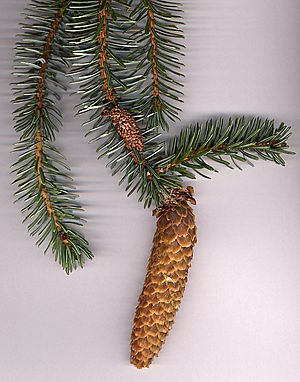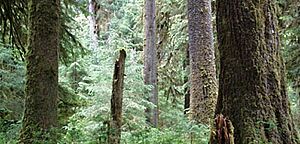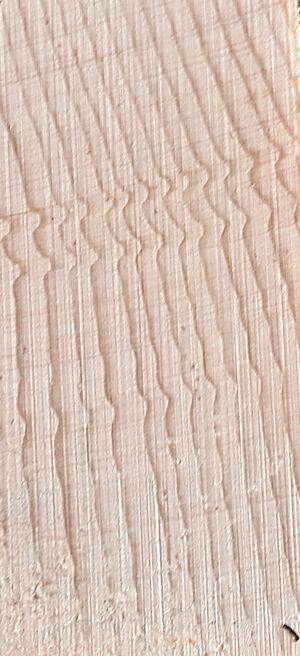Sitka spruce facts for kids
Quick facts for kids Sitka spruce |
|
|---|---|
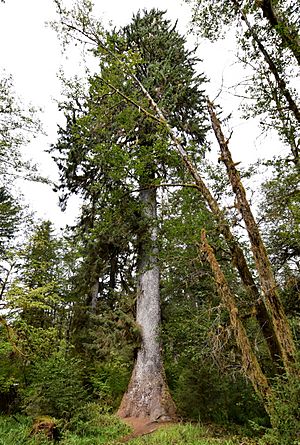 |
|
| Sitka spruce in the Hoh Rainforest in Olympic National Park | |
| Conservation status | |
| Scientific classification | |
| Genus: |
Picea
|
| Species: |
sitchensis
|
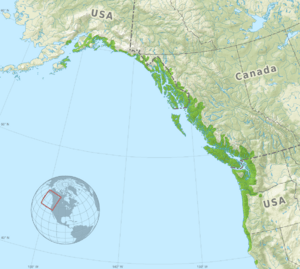 |
|
| Range highlighted in dark green | |
| NCBI genome ID | 3332 |
|---|---|
| Ploidy | 2 |
| Genome size | 20 Gbp |
| Number of chromosomes | 12 |
| Sequenced organelle | plastid and mitochondrion |
| Organelle size | 124 kbp and 5.52 Mbp |
| Year of completion | 2016 and 2019 |
The Sitka spruce (also known as Picea sitchensis) is a giant evergreen tree. It is a type of conifer, which means it has cones and needles instead of leaves. These trees can grow to be almost 100 meters (330 feet) tall! Their trunks can be wider than 5 meters (16 feet).
The Sitka spruce is the largest type of spruce tree in the world. It is also the fifth-largest conifer overall. It is the third-tallest conifer, after the coast redwood and coast Douglas fir. Some Sitka spruces have been measured at over 90 meters (300 feet) tall. The tree gets its name from Sitka, Alaska, where it grows a lot. You can find Sitka spruce trees along the western coast of Canada and the United States, all the way down to northern California.
Contents
What Does a Sitka Spruce Look Like?
The bark of the Sitka spruce is thin and flaky. It peels off in small, round pieces. Young trees have a wide, cone-shaped top. Older trees have a more cylinder-shaped top. Very old trees might not have branches on their lower trunks, sometimes up to 30 to 40 meters (100 to 130 feet) high.
The branches are a very light brown, almost white. The leaves are stiff and sharp, like needles. They are about 15 to 25 millimeters long. The needles are flat and a dark blue-green on top. They have blue-white lines underneath.
Cones and Seeds
The cones hang down from the branches. They are long and thin, about 6 to 10 centimeters (2.4 to 4 inches) long when closed. When they open, they are about 3 centimeters (1.2 inches) wide. The cones have thin, bendy scales. They are green or reddish when they are young. They turn light brown about 5 to 7 months after the tree is pollinated.
The seeds are black and very small, about 3 millimeters long. Each seed has a thin, light brown wing that is about 7 to 9 millimeters long. This wing helps the seeds fly away in the wind.
How Big Do They Get?
For over a hundred years, many Sitka spruce trees have been cut down for wood. Because of this, only a few of the very largest trees are left. Trees over 90 meters (300 feet) tall can still be found in places like Pacific Rim National Park in British Columbia. The Carmanah Giant in Canada is 96 meters (315 feet) tall, making it the tallest tree in Canada.
You can also find very tall Sitka spruces in Olympic National Park in Washington. Two trees in Prairie Creek Redwoods State Park in California are just over 96 meters (315 feet) tall. The Queets Spruce is the largest Sitka spruce in the world by trunk size. It is 74.6 meters (245 feet) tall and has a trunk volume of 346 cubic meters (12,220 cubic feet). It is located in Olympic National Park.
How Old Are They?
Sitka spruce trees can live for a very long time. Some trees are known to be over 700 years old! However, these trees grow very fast when conditions are good. So, a very large tree might not always be super old. For example, the Queets Spruce is estimated to be only 350 to 450 years old. But it adds more than one cubic meter of wood every year!
Roots and Fire
Sitka spruce trees live in very wet places. Because of this, they have shallow roots that spread out wide. They do not have many deep roots. Even though they live in wet climates, their thin bark and shallow roots make them easy to damage by fires.
Where Do Sitka Spruces Live?
The Sitka spruce is native to the west coast of North America. It grows from the Kenai Peninsula in Alaska down to northern California. These trees are often found in temperate rain forests. They usually grow within a few kilometers of the coast. In areas north of Oregon, they can be found further inland along rivers. However, they never grow more than 80 kilometers (50 miles) from the Pacific Ocean.
Sitka spruce trees have also been planted in Europe for their wood. They were first planted there in the 1800s. Now, Sitka spruce forests are very common in Great Britain and Ireland. They are also found in France and Denmark. The tree was brought to Iceland and Norway in the early 1900s.
What Are Sitka Spruces Used For?
Sitka spruce is very important for making timber and paper. Outside of its native home, it is valued because it grows quickly, even in poor soil or windy places where other trees might not grow well. In perfect conditions, young trees can grow 1.5 meters (5 feet) taller each year!
The tree was brought to Ireland and Great Britain in 1831 by a botanist named David Douglas. It also grows in New Zealand. Sitka spruce is planted a lot in Denmark, Norway, and Iceland. In Norway, it was introduced in the early 1900s. About 50,000 hectares (123,500 acres) have been planted there. It can handle wind and salty ocean air better than the native Norway spruce and grows faster. However, in Norway, the Sitka spruce is now seen as an invasive species. People are trying to remove it.
Musical Instruments and Aircraft
Sitka spruce wood is used a lot to make musical instruments like pianos, harps, violins, and guitars. This is because its wood is very strong but light. It also has regular, knot-free rings, which makes it great for carrying sound.
For these same reasons, the wood is also used for parts of sailboats and aircraft wings. The Wright brothers used Sitka spruce to build their first airplane, the Wright Flyer. Many aircraft before World War II were also made with it. During the war, British planes like the de Havilland Mosquito used Sitka spruce instead of aluminium, which was harder to get.
Other Uses
The fresh tips of Sitka spruce branches are used to flavor spruce beer. They can also be boiled to make syrup. The root bark of Sitka spruce trees is used by Native Alaskan people to weave baskets.
Special Trees
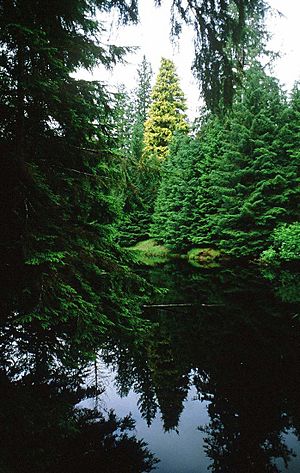
There was a very special Sitka spruce tree with golden needles that grew on Haida Gwaii, an island in Canada. It was called Kiidk'yaas, or "The Golden Spruce." This tree was sacred to the Haida First Nations. Sadly, it was illegally cut down in 1997. However, young trees grown from cuttings of the original tree can now be found near its old spot.
Burls
In the Olympic National Forest in Washington, some Sitka spruce trees near the ocean grow strange bumps called burls. These burls form when the tip or a bud of the tree gets damaged. This damage makes the tree's growth cells divide faster than normal, creating the swelling. Even though burls might look a bit scary, they do not hurt the tree's overall growth.
Images for kids
See also
 In Spanish: Pícea de Sitka para niños
In Spanish: Pícea de Sitka para niños



